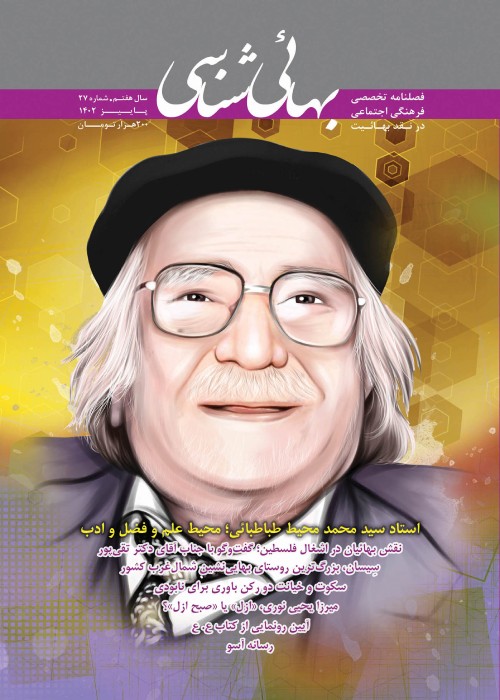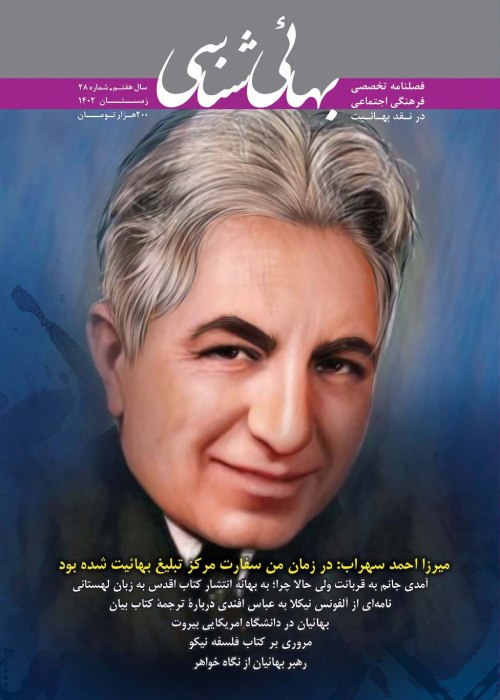فهرست مطالب

نشریه بهائی شناسی
پیاپی 27 (پاییز 1402)
- تاریخ انتشار: 1402/08/16
- تعداد عناوین: 13
- سرمقاله
-
صفحات 4-17
- روی خط خبر
-
صفحات 18-24
-
دیدار در تبریز / گزارش شرکت انتشارت گوی و موسسه بهائ یپژوهی در هجدهمین دوره نمایشگاه کتاب تبریزصفحات 25-27
-
صفحات 28-31
-
صفحات 32-41
-
مرحمت فرموده ما را مس کنید / نگاهی به بیانیه 4 دسامبر BICصفحات 42-45
- مصاحبه
-
نقش بهائیان در اشغال فلسطین / گفت وگو با جناب آقای دکتر تقی پورصفحات 46-71
-
صفحات 72-101
استاد سیدمحمد محیط طباطبایی (1280-1371ش) از برجستهترین پژوهشگران ادبی، فرهنگی، تاریخی و از منتقدان و ادیبان ایران بود و آثار محققانه فراوانی را از خود به جای گذاشت. استاد در موضوع بهاییت تحقیقاتی بینظیر در کتب اصلی و تاریخی آنان انجام داده و با تخصص نسخه شناسی خود، نشان داده است که آثار اصلی بهایی همچون کتاب اقدس و کتاب ایقان از اغلاط، تحریف، جعل و قلب واقعیت مصون نمانده و این حجم از نارسایی های علمی و ادبی و متنی، نشان از بشری بودن و الاهی نبودن این آیین دارد. وی همچنین تحقیقاتی تاریخی انجام داده و کتب تاریخی اصلی بهاییت را به چالش کشیده است.
کلیدواژگان: سیدمحمد محیط طباطبائی، بهائیت، بابیت، کتاب اقدس، کتاب ایقان، کتب تاریخی بهائیت، جانشین سید باب -
معرفی کتاب حیات یحیای نجی؛ بخش نخست: میرزا یحیی دولت آبادی، از جنبش باب تا جنبش مشروطیت (سیدمقداد نبوی رضوی) / قسمت اول: بررسی نکات تاریخی کتابصفحات 102-127
میرزا یحیی دولتآبادی یکی از برجستگان سیاسی و فرهنگی نیمه پایانی پادشاهی قاجار و نیز دوره رضاشاه پهلوی است که با نگارش خاطرات زندگانی خود با نام «حیات یحیی» روایتهای مهمی از تاریخ آن سالها را از خود به جای گذاشته است. این مقاله بر آن است تا در چهار بخش، با مرور کتاب «حیات یحیای نجی» (نوشته سیدمقداد نبوی رضوی)، آنچه را که او از زندگانی پنهان بابی و ازلی خود عامدانه نیاورده و در اسناد و مدارک چاپ نشده آمده، نشان دهد. آگاهی از ایندست ناگفته های تاریخ ایران، در تحلیل آن جایگاه مهمی دارد. بخش نخست این مقاله که اکنون دیده میشود مروری بر نکات تاریخی کتاب «حیات یحیای نجی» است.
کلیدواژگان: میرزا هادی دولت آبادی، میرزا یحیی دولت آبادی، ناصر دولت آبادی و کتاب حیات یحیی -
صفحات 128-141
رسانه آسو یکی از زیرمجموعه های بنیاد تسلیمی در سانتامونیکای آمریکاست. در قسمت نخست این مقاله درباره بنیاد تسلیمی سخن گفته شد. رسانه آسو با ترویج اندیشه لیبرالی غرب، میکوشد تا قرایتی روشنفکرانه از آموزه های بهایی ارایه دهد. پیشتر گفته شد که از ابتدای دهه هفتاد میلادی، برخی از بهاییان تلاش کردند تا آموزه های بهاییت را، خصوصا در حوزه امور اجتماعی، بازخوانی کنند. مشکل از آنجا آغاز میشد که بهاییت مدعی ارایه آموزه های مدرن بود اما بسیاری از آورده های آن هیچ تناسبی با اندیشه مدرن نداشت. این ناهماهنگی سبب شد تا ابتدا جمعی از روشنفکران بهایی دیدگاه هایی انتقادی مطرح کنند و حتی سازمان بیتالعدل را به چالش بکشند، که البته این گروه به سرعت با تیغ بران بیت العدل گرفتار سانسور و طرد از بهاییت شدند، اما جریان دیگری با حمایت خاموش بیت العدل، بدون کوچکترین نقد به آموزه های بهاییت و عملکرد دوگانه بیت العدل، با ارایه قرایت سفید از بهاییت تلاش کرد با ایجاد دگردیسی معرفتی، بدون آنکه مستقیما دیدگاه های نخستین بهاییت را تغییر دهد، روایتی مدرن از آموزه های بهایی ارایه کند. رسانه آسو در راستای فعالیت گروه دوم میکوشد با سفید کردن عملکرد بهاییت و بدون اشاره به دیدگاه منتقدان، روایتی یکسره مثبت از بهاییت ارایه دهد. عملکرد این رسانه را میتوان در راستای پروپاگاندای سازمان بیت العدل نگریست.
کلیدواژگان: رسانه آسو، بنیاد تسلیمی، لیبرالیسم، بیت العدل -
صفحات 142-171
میرزا یحیی نوری (جانشین سید علیمحمد باب و مدعی میرزا حسینعلی بهاءالله) یکی از کسانی است که تحلیل شخصیت، جایگاه و کارهایش در شناخت درست تاریخ و آموزه های بابیان و بهاییان دخالت مبنایی دارد. او در میان بابیان با لقبهایی چون «ثمره»، «وحید اعظم»، «وجه»، «نور»، «ازل» و «صبح ازل» شناخته میشد اما بهاییان در بهترین حالت او را «ازل» یاد میکردند. این مقاله در ادامه پژوهشی پیشین (میرزا حسینعلی نوری، از «بهاء» تا «بهاءالله») بر آن است تا به این پرسش پاسخ دهد که با توجه به آنچه از باب به جای مانده، آیا میرزا یحیی نوری را با لقب های «ازل» و «صبح ازل» میتوان یاد کرد یا خیر؟ بررسی آثار باب و پیروانش چنین مینمایاند که او را با هردو لقب میتوان خواند به خلاف میرزا حسینعلی نوری که نه «بهاء» و نه «بهاءالله» برای او لقبهایی برخاسته از آموزه های باب نبودند.
کلیدواژگان: سید علی محمد باب، میرزا یحیی نوری، ازل و صبح ازل -
صفحات 172-237
روستای سیسان، در استان آذربایجان شرقی واقع شده است. این روستا پیش از پیروزی انقلاب اسلامی، بزرگترین روستای بهایی نشین شمال غرب کشور بود. در این نوشتار روش های تبلیغی بهاییان در آنجا، بررسی شده است. این روش ها شامل تهدید با اسلحه، کمک مالی به مسلمانان فقیر، ازدواج دختران بهایی با جوانان مسلمان، ارسال پزشکان بهایی، اعزام مبلغان بهایی، خرید زمینهای مسلمانان و تضعیف توان اقتصادی ایشان و پخش فیلمهای بهایی همراه با ارایه نمونه هایی توضیح داده شده، برخی از فعالیتهای بهاییان روستای سیسان و پشتیبانی های تشکیلاتی بهاییان در آنجا است. همچنین نمونه هایی از خشونت های بهاییان علیه مسلمانان که به دلایل مختلف انجام دادهاند، همچون دست داشتن در حمله به طلاب مدرسه فیضیه و درگیریهایی با مسلمانان به دلایل مختلف، مثل اعزام به سربازی، ارایه شده است. عملکرد تاریخی بهاییان پس از انقلاب اسلامی ایران در مواجهه با ارشادات علما و گفت و گوهای روشنگرانه آنان نیز مورد مطالعه قرار گرفته و مشاهده شده است که به دلیل تبلیغات اسلامی، تعدادی از بهاییان مسلمان شدند و تشکیلات بهاییت دستور مهاجرت عمومی بهاییان از آنجا را صادر نمود. پس از آن بهاییان سیسان تظلم کردند که مسلمانان آنان را بیرون کردهاند، درصورتیکه طبق مدارک موجود هیچگونه اجباری بر مهاجرت آنان و یا ظلم به آنان در آن زمان صحت نداشته است. هنوز هم در سایتهای بهایی، ظلم ادعایی بر بهاییان سیسان تکرار میشود و جمهوری اسلامی را متهم می نمایند، که در این نوشتار به آن پاسخ داده شده است.
کلیدواژگان: بهائیت، سیسان، آذربایجان شرقی، فیضیه، خشونت فرقه ای -
صفحات 238-242
-
Pages 72-101
Mr. Seyyed Mohammad Mohit Tabatabayi (1280-1371 solar) was one of the most prominent literary, cultural, historical researchers, critics and writers of Iran and left behind many research works. The professor has conducted a unique research on the subject of Baha’ism in their original and historical books, and with his expertise in original texts , he has shown that the original Baha’i works such as Kitab Aqdas and Kitab Iqan have not been immune from falsification, distortion and forgery, and the heart of reality. This volume of scientific, literary and textual inadequacies in these two books shows that this religion is human and not divine. He has also done historical research and challenged about the main Baha'i history books.
Keywords: Seyyed Muhammad Mohit Tabataba'i, Baha’ism, Babism, Kitab Aqdas, Kitab Iqan, Baha'ihistorical books, the successor of Sayyid Bab -
Pages 102-127
Mirza Yahya Daulatabadi is one of the prominent political and cultural figures of the last half of the Qajar kingdom and the era of Reza Shah Pahlavi. This article aims to show in four parts, by reviewing the book "The Life of Yahya Najji" (written by Seyyed Meqdad Nabavi Razavi), showing what he deliberately did not bring from his past and hidden life and was not published in the documents. Knowledge of such untold things in Iran's history has an important place in its analysis. The first part of this article - which can be read now - is a review of the historical points of the book "The Life of Yahya Najji".
Keywords: Mirza Hadi Dolatabadi, Mirza Yahya Dolatabadi, Naser Dolatabadi, Hayat Yahya'sbook -
Pages 128-141
Media is one of the subsets of Taslimi Foundation in Santa Monica, USA. In the first part of this article, we talked about Taslimi Foundation. Also, the Aasoo media tries to present an intellectual reading of the Baha'i teachings by promoting the liberal thought of the West. It was said earlier that from the beginning of the 70s, some Baha'is tried to revise the Baha'i teachings, especially in the field of social affairs. The problem started from the fact that Baha’i claimed to present modern teachings, but many of its teachings did not correspond to modern thoughts. This incident caused a group of Baha’i intellectuals to express critical views and even challenge the Universal House of Justice Baha’i organization. Consequently, this group was soon caught in censorship and rejection of Baha’i by the blades of the UHJ, But another Baha’is with secret silent support of UHJ , without the slightest criticism of the Baha'i teachings and the double function of the UHJ, tried to present a modern narrative of the Baha'i teachings by creating an epistemological metamorphosis, and without directly changing the views of the first Baha'ism views . In line with the activities of the second group, Aasoo media tries to present a completely positive narrative of Baha'i by whitewashing the performance of Baha'i and without referring to the critics' point of views. The performance of this media can be seen in line with the propaganda of UHJ organization.
Keywords: Aasoo Media, Taslimi Foundation, Liberalism, Bait al-Ad, UHJ -
Pages 142-171
Mirza Yahya Noori (the successor of Mirza Ali Muhammad Bab and the opponent of the leadership of Mirza Husayn Ali Baha'u'llah) is one of those whose personality, status and works analysis has a fundamental role in the correct understanding of the history and teachings of Babies and Baha’is. Among the Baha’is, he was known by nicknames such as "Thamareh", "Vahid Azam", "Vajh", "Noor", "Azal" and "Sobhe Azal", but the Baha'is called him "Azel" at best. This article, in continuation of the previous research (Mirza Hossein Ali Nouri, from "Bahá" to "Baha’u’llah"), aims to answer the question that according to what is left of the chapter, whether Mirza Yahya Nouri was named "Azal " and Can "Sobhe Azal " be memorized or not? Examining the works of the Báb and his followers shows that he can be called by both nicknames, unlike Mirza Hossein Ali Nouri, for whom neither "Bahá" nor "Baha’u’llah" were nicknames derived from the Báb's teachings.
Keywords: Mirza Ali Mohammad Bab, Mirza Yahya Nouri, Azal, Sobhe Azal -
Pages 172-237
Sisan village is in the East Azarbaijan province in the northwest of Iran. Before the victory of the Islamic Revolution, this village was the largest Baha'i village in the northwest of the country. The Baha'i propaganda methods there include threats with guns, financial aid to poor Muslims, marriage of Baha'i girls to young Muslims, sending Baha'i doctors, sending Baha'i missionaries, buying Muslim lands and weakening their economic power, showing Baha'i films (along with providing examples in this article ). Some activities of the Baha'is of Sisan village and the organizational support of the Baha'is there have been investigated. Examples of violence that Baha'is have done for various reasons, such as being involved in the attack on the students of Faiziyeh School, conflicts with Muslims for various reasons, such as being sent them to the military services, have been presented. The historical performance of the Baha'is after the Islamic Revolution of Iran in the face of the guidance of the scholars and their enlightening conversations has also been studied and it has been observed that due to the Islamic propaganda, a number of Baha'is became Muslims and the Baha’i organization ordered the general migration of the Baha'is from there and then they were claimed that they were oppressed. They showed that the Muslims expelled them, but according to the available evidences, there was no compulsion on their migration or oppression against them at that time.
Keywords: Baha'i, Sisan, East Azarbaijan, Faizyeh, sectarian violence6


